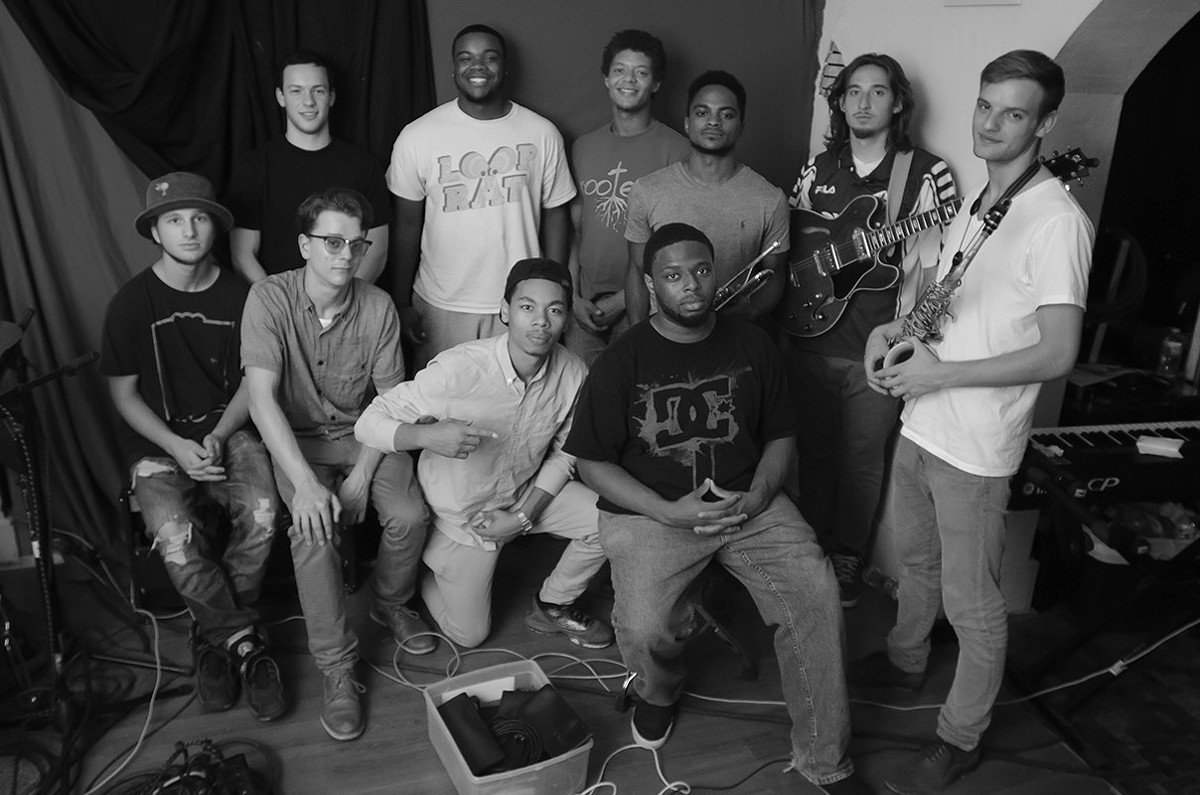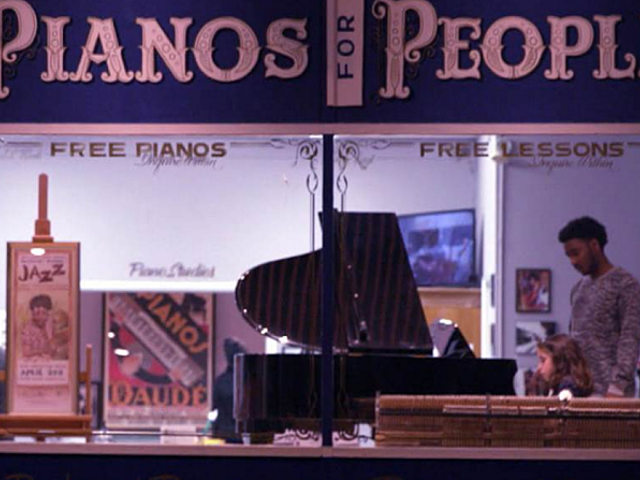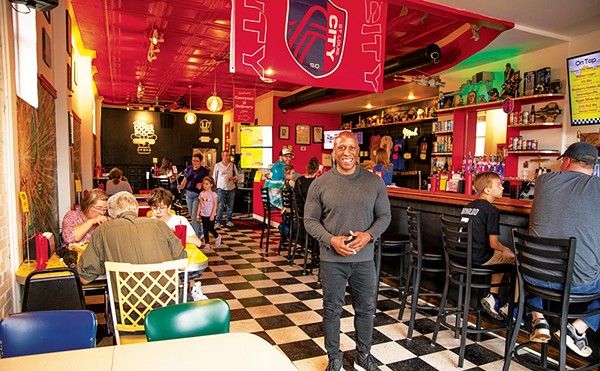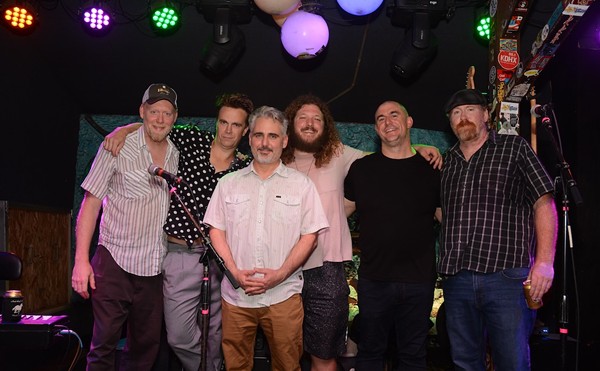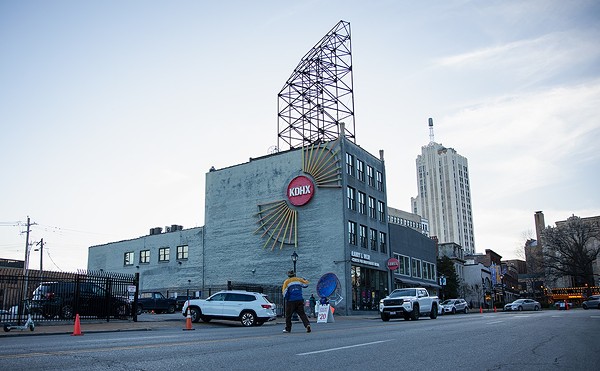Spend any significant amount of time discussing the Delmar Loop and you'll eventually land on the subject of race. The bustling entertainment and shopping district sits on Delmar Boulevard, the street at the center of St. Louis' infamous Delmar Divide — the line that separates and segregates the city's predominantly white population to the south from its largely black population to the north. The Loop, located just west of St. Louis proper in University City, sees these two communities come together, eating and shopping or taking in a show at the Tivoli or the Pageant.
In a perfect sort of way, St. Louis' Looprat straddles the Delmar Divide, with an almost-even mix of black and white members. And while you don't often see musical groups so self-consciously associate with a specific neighborhood in St. Louis, Looprat's name is a dead giveaway.
A ten-person jazz/hip-hop group comprised of six instrumentalists and four MCs, the act owes its existence to the University City High School jazz band, where more than half its members met. Though it has been almost three years since Looprat released its first album, the group still stays close to the neighborhood, and many of its recent music videos feature a saunter down the Loop (sometimes to the confusion of packs of older tourists).
But you'd be wrong to assume that Looprat represents a modern conception of Coca-Cola's "Teach the World to Sing" commercial. The group incorporates many influences, but the result is neither perfect, flat harmonies nor a blend of discordant sounds. Instead, Looprat produces a smooth, seamless mix of nimble jazz instrumentation with heady hip-hop lyricism. In a way, Looprat's genre-resistance reflects the music scene in the Loop itself (a solo flutist on one sidewalk, a folk group on another) — and the St. Louis scene in general.
"I think that the St. Louis music community is really diverse," says Alex "Mugen" Yentumi, one of the group's MCs. "There is a very eclectic taste of music here."
"With really tight-knit subgenres though," says Nate "NatKingFlo" King, another MC.
"But also nobody's really doing the same thing as anybody else," Yentumi adds. "So we're just trying to continue that momentum, working with the different groups and understanding that dynamic of the city's music, where everybody's doing a unique thing but people come together too."
The band's most recent album, How Live?, released in August, starts off with "The New Edition," a track that epitomizes the possibilities in the group's collaboration. The song begins with a simple falling piano line, courtesy of keyboardist Ben Aronberg, that could easily introduce a song of practically any genre. From there, Zach Morrow's drums punch in as Yentumi, King and the group's additional MCs (David Napalm, Will-Be) trade verses. The last four minutes of the six-minute song are devoid of vocals, instead playing out like a traditional jazz instrumental, thanks to the deft contributions of Joey Ferber (guitar), Albert Marshall (bass), Sam Katz (saxophone) and Khamali Cuffie-Moore (trumpet). This feeling continues into the beginning of the second track, "Life's Work," with a simple loop that serves as a blank slate for the four MCs to return and spit bars.
"Every MC that we work with definitely has a very unique voice," says King. "I'd be hard-pressed to tell you even one or two rappers that sound like them, which I think is pretty dope."
This is what you can expect throughout How Live?: a continuous mingling of genres: jazz, hip-hop, funk, blues. The songs don't sound forced, like a low-energy "Diversity Day" in a cubicle farm. The mixes are simply seamless and natural, appealing to real hip-hop fans (the group performed a Halloween show this past October called "Hip Hop Ain't Dead Yet!") as well as older folks who prefer more mellow jazz tracks (the group plans to release instrumental versions of its songs for those listeners).
Citing influences from Stan Getz, Charlie Parker and Bela Fleck to local genre-bending groups Vulfpeck and Midwest Avengers, King and Yentumi say that everyone in the group brings something to the table, despite Looprat's lack of an obvious leader or fulcrum, as you often see in larger jazz groups.
So far, the group's cohesive approach to songwriting has paid off, though it sometimes takes some back and forth. "Life's Work," which is featured on Looprat's How Live?, was almost nixed off the album's tracklist a few days before its recording session.
"The song started as a beat that David Napalm made," King explains. "Dave, Mugen and I rapped on that beat and recorded to it at David's house, and then we showed the recording with the instrumental to a couple people in the band."
Though the group liked the beat, King says that it seemed slightly too boring to warrant recording.
"It was all in one key," he explains. But, "then our saxophone player added how the instrumental goes up and up and up, chromatically, throughout the whole song." Instead of being abandoned, "Life's Work" turned into the group's most successful song, garnering more than 40,000 listens on Spotify.
A number of Looprat members are still in college, though King will be graduating from Webster this winter. Looking forward, the group plans to keep performing, in St. Louis, Chicago and points beyond. In terms of where the music could go, though, they can't really say. It's already come a long way from first-period jazz standards.
"It's weird how well we come together despite how different our overall writing styles are, how we each grew up and our cultural backgrounds," says Yentumi. "It's all super diverse, but it's all seamless."

